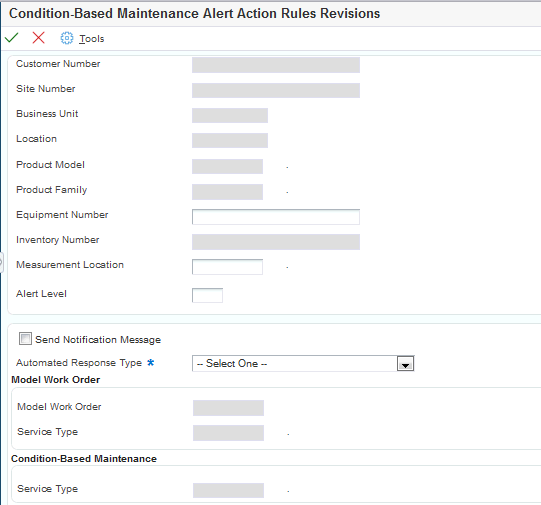Setting Up Alert Action Rules
Access the Condition-Based Maintenance Alert Action Rules Revisions form.

The fields that are available for entry are determined by the Alert Action Rule Sequence that is selected.
- Customer Number
Enter a number to identify an entry in the JD Edwards EnterpriseOne Address Book system, such as employee, applicant, participant, customer, supplier, tenant, or location.
- Site Number
Enter an address book number for the lessor, renter, or lending institution.
- Business Unit
Enter an alphanumeric code to identify a separate entity within a business for which you want to track costs. For example, a business unit might be a warehouse location, job, project, work center, branch, or plant.
You can assign a business unit to a document, entity, or person for purposes of responsibility reporting. For example, the system provides reports of open accounts payable and accounts receivable by business unit to track equipment by responsible department.
Business unit security might prevent you from viewing information about business units for which you have no authority.
- Location
Enter the current physical location of an asset. The location must have a valid business unit or job number in the Business Unit Master table (F0006).
- Product Model and Product Family
Enter a code to classify an inventory item into a model or group for customer service.
Examples include Laser Printer, InkJet, and Fax.
- Equipment Number
Enter a numeric value up to eight digits that uniquely identifies an asset.
- Inventory Number
Enter an inventory item number. The system provides three separate item numbers plus an extensive cross-reference capability to other item numbers to accommodate substitute item numbers, replacements, bar codes, customer numbers, supplier numbers, and so forth. The item numbers are:
Item Number (short): An eight-digit, computer-assigned item number.
2nd Item Number: A 25-digit, free-form, user-defined alphanumeric item number.
3rd Item Number: A 25-digit, free-form, user-defined alphanumeric item number.
- Measurement Location
Enter a value from UDC 13/LC (Measurement Location) that indicates a measurement location on a piece of equipment. This field enables you to further define the alert action rule to determine whether alert notifications are sent, and what response to use for the incoming alert. If you have not defined an alert action rule that is specific to a particular measurement location, leave this field blank to define an alert action rule that you can use for any measurement location.
- Alert Level
Enter a value from UDC 13/LC (Alert Level) that indicates the functional status of a piece of equipment, as assessed by a condition-based maintenance system. This field enables you to further define the alert action rule to determine whether alert notifications are sent, and what response to use for the incoming alert. If you have not defined an alert action rule that is specific to an alert level, leave this field blank to define an alert action rule that you can use for any alert level.
- Send Notification Message
Select this option to specify whether a notification message is sent when a condition-based alert is entered into the system.
- Automated Response Type
Enter a value that indicates the type of automatic response that is required when a condition-based alert is entered in the Condition-Based Alerts table (F1310). Values are listed in UDC table 13/AR (Automatic Response Type). Values include:
1 No Automatic Response: This option allows the user to review the alert and manually trigger a response from the Condition-Based Alerts Workbench program (P1310).
2 Create Investigation Message: This option automatically creates an investigation message using information from the condition-based alert record.
3 Create WO from Model: This option automatically creates a work order using the model work order information from the condition-based alert record.
4 Update PM Schedule: This option automatically updates the Maintenance Schedule File table (F1207) using the asset number and service type information from the condition-based alert record.
Note: To perform the automated response-type processing, you must run the Condition-Based Alerts Processor program (R1312).